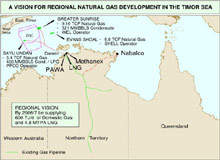
Although a number of companies had announced plans to develop the Sunrise gas field in the Timor Sea off the north-west coast of Australia the project was frozen in 2004 so that Australia and Timor Leste could work out the revenue split.
In April 2007 both countries agreed to a 50/50 split. Development of the field is now expected to start in about two years with production to come on-stream properly by 2013. Timor Leste is a small island who gained independence from Indonesia in 2002 and whose economy needs the boost of a major gas project.
With the Bayu-Undan gas already successful it is hoped that the large reserve base of the Greater Sunrise fields (eight trillion cubic feet of gas and 300 million barrels of condensate) will generate $40bn over its projected lifetime of 30 years.
Sunrise has the potential to support liquefied natural gas, methanol, power generation and other gas-based industries including minerals processing. The gas has to be accessed using offshore drilling rigs, with the attendant facilities such as subsea pipes, christmas trees, tankers and so on. But there is currently much debate at the moment about how the gas should be recovered and processed.
Options are to transport the gas to Darwin in Northern Australia, process at sea on an offshore LNG plant (Shell plan) or pipe the gas to East Timor for processing at an LNG liquefaction terminal there for export. The project to exploit these gas reserves is likely to require an investment of $5bn.
THE SUNRISE GAS FIELD
Offshore exploration of the Bonaparte Basin off the north west coast of Australia during the mid-70s led to the discovery of the Sunrise and Troubadour gas fields. Together with the Sunset gas field, they comprise the Greater Sunrise gas fields, located about 500km north-west of Darwin.
Shell and its partners (Woodside Energy and Osaka Gas) in the project are currently working towards the commercialisation of these vast reserves. Extensive appraisals of the gas fields have been completed, with the largest single 3D seismic programme in Australia undertaken from July to September 2000.
The area can provide gas resources for over 30 years and in July 2000 it was awarded major project facilitation status by the Australian government before being frozen in 2004 due to disagreement over revenue split.
FLOATING LIQUIFIED NATURAL GAS TECHNOLOGY
In 1997, Shell began feasibility studies on a new method of producing natural gas. The principle is that a production plant would be on a floating barge which can go to a gas field and process the gas at the field rather than transporting it via expensive pipelines to an onshore plant.
The barge would be capable of offloading the gas directly onto ships, negating the need for pipelines and onshore plants. The reduced cost implications of this method would make it far more cost effective to reach smaller and more remote gas reserves. The floating plant could also be used at different locations during its working life.
LEAD CONTRACTORS
Phillips Petroleum began a two-phase project beginning with a $1.5bn gas recycle project connected to the Bayu-Undan gas field. In late 2003, the project began producing and processing the gas, separating and selling the liquids, and re-injecting the gas back into the reservoir. Full commercial production began in 2004.
The second phase will be a gas project and will proceed as gas markets are developed. The company has also built a subsea pipeline from the Bayu-Undan project to Darwin, Australia (Darwin LNG project started up in 2006). The Sunrise Field was not involved in this but clearly now there is potential for a tieback to use the existing infrastructure.
Osaka gas signed an agreement with Woodside Energy and Shell Development in 2000 for an acquisition of 10% of the concession rights in the two gas fields (Bayu-Undan and Sunrise).
Osaka Gas has maintained a cooperative relationship with the two companies to date and it believes that the company’s expertise in LNG transport and marketing can be combined with the exploration and production know-how of the two Australian producers for mutual benefits.
BENEFITS OF THE SUNRISE GAS PROJECT
Australia stands to benefit from a new long-term natural gas supply, employment growth, new export industries producing LNG, methanol and other derivatives from new-generation plant and potential spin-off development, and increases in taxation revenue for the Northern Territory and Australian governments.
Timor Leste stands to benefit from taxation revenue, education, training and employment opportunities and possibly LNG export revenue.
Other benefits will be derived from more efficient industries, increased use of natural gas in place of less efficient fuels and reduced greenhouse gas emission rates, the extension of reliable gas supplies to underpin the national gas grid and potentially improve supply security for customers in Queensland, New South Wales and South Australia.



